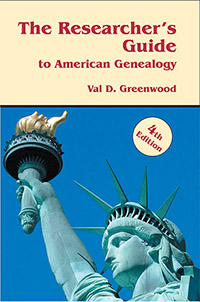
Genealogists Need Libraries
Chapter Five of The Researcher’s Guide to American Genealogy. 4th Edition, by Val Greenwood, is entitled “Libraries and the National Archives (NARA).” In a way the chapter title is understated because many libraries have digitized their family history holdings (e.g., personal papers, published family histories, military records, etc.) and made them available for free on the Internet. If you have a library card, you may be able to access commercial sites like Ancestry.com, My Heritage, or GenealogyBank for free by getting on the web site of your local public library. Then there are the vast collections of FamilySearch.org, its Family History Centers, and the large “affiliated” genealogy libraries, most of whose records are very much worth checking out either online or in person. The National Archives, of course, houses its own enormous cache of military and civil records going back to the founding of the United States. A number of the leading genealogical societies also have large in-house and, in some cases, online libraries, too.
The following excerpt from pp. 99-101- and p. 103 captures the flavor of Chapter 5 and should motivate you to move library research high up on your genealogy “to do” list. View “The Researchers Guide”
Libraries and the National Archives (NARA)
Practically every activity in which people participate has special requirements of some kind. Some activities require the use of distinctive tools or equipment. Others are limited to unique places or particular types of facilities. Family history research falls into this last category, and a library is one such facility. In libraries, we can find some of the tools and the materials we need for our research. Even in this age of digitization, when we rely so much on computers and the Internet, libraries are critical to what we do. In fact, the use of computers and digital technology has made it even more critical for us to understand libraries and the role they play in our work. We must understand how to use them effectively and efficiently.
1. THE PURPOSES OF LIBRARY RESEARCH
At the very beginning of this discussion, I want you to know that there is still much we do not understand—and it seems to become more that way every day. Everything we know and everything we do seems to be in transition. We used to be able to say with some certainty that most family history research was not done in libraries—at least not in traditional libraries. However, it seems that nothing can be said with absolute certainty anymore. And what we think we can say with certainty on one day may not be true a few days later. This is not necessarily bad, but it does require us to pay attention, so we do not get left behind.
In this time of transition, we must be careful to keep a realistic perspective on what is going on around us. Research is still research. The principles we talked about earlier in this book are still valid and need to be applied. There can, however, be a significant amount of variation in how we apply those principles—all depending on the localities where our problems are centered and the availability of the evidence required to to solve our ancestral issues.
It is still true that those who spend all of their time in libraries searching for and reading published family history books do not comprehend what correct family history research is all about. However, if one is fortunate and if his ancestors happened to live in the right places, many libraries today have resources that accommodate much primary research.
Some libraries mentioned in this chapter—as well as many, many others— have vast collections of original records as well as microform (film or fiche) and/or digitized copies of original records available for research. That fact can change your approach to many of your research problems. The difference is in the availability of critical records, both microform and digitized—as well as the availability of indexes to many of those records. If essential record collections of those places where your ancestors lived are available in a library convenient to you, it would be foolish not to take full advantage of those resources. It would be foolish, even, not to travel some distance if that were necessary to gain access to those valuable records.
Although the collections of most public libraries have significant inadequacies insofar as family history research is concerned, most have a few histories, published genealogies, and other resources that can and should be checked as part of our preliminary survey. Much information and many valuable clues can often be gleaned in a few well-spent hours in a public library. Such has always been the case.
The big difference we deal with, however, relates to the technological advances of the past few years and the innovative people and diligent indexers who are working miracles to make those advances serve the needs of family history researchers. And there are resources available—almost at our fingertips—that have changed the world for us.
Today family history websites, with their vast collections of digitized records, make a significant difference. We can subscribe to these websites and use their resources to whatever extent we desire and can afford. Many of them have significant subscription fees if we use them on the computers in our homes or on our mobile devices, but we can use the library editions of these websites free of charge in many local libraries. These include such vast collections as those of Ancestry, MyHeritage, and FindMyPast. These are available for the free use of library patrons who will come in and use them.
Also, Latter-day Saint Family History Centers have the following online collections available for patron use without charge: NewspaperARCHIV. com; the “American Civil War Research Database” from Alexander Street Press; Ancestry; FindMyPast; Fold3; HeritageQuest Online; and Historic Map Works (Library Edition).
All you have to do is go to the library or the Family History Center and use them. If you do not have a Family History Center close by, it may be worth your while to check with your local public library to see what they have. If they do not currently subscribe to these websites, perhaps you can convince them of the benefits.
Not only are more family history resources now accessible to us in our libraries than ever before, but most U.S. libraries now have their library catalogs on the Internet so we can check to see what is available before we leave home for our library visit. Section IV of this chapter discusses the use of these online library catalogs.
III. FAMILYSEARCH LIBRARIES
At various locations in the western U.S. (and likely to follow soon in other locations), the Family History Library in Salt Lake City has established facilities during the past few years that they call FamilySearch Libraries. Most of these are in the same physical facilities where branch Family History Centers once functioned. These libraries are publicized as “library class facilities” and are a boon to those living in the areas where they are located. They provide access to the resources of the LDS Church, and are not comparable to the branch libraries that most of them replaced. There are (as of this writing) thirteen FamilySearch Libraries, located in five states. Following is a list of these FamilySearch Libraries with their websites, both the local website URL (where applicable) and the FamilySearch wiki URL:
ARIZONA
- MESA FAMILYSEARCH LIBRARY, 41 S. Hobson St., Mesa, AZ 85204
CALIFORNIA
- LOS ANGELES FAMILYSEARCH LIBRARY, 10741 Santa Monica Blvd., Los Angeles, CA 90025
- OAKLAND FAMILYSEARCH LIBRARY, 4766 Lincoln Ave., Oakland. CA 94602
Recent Blog Posts




